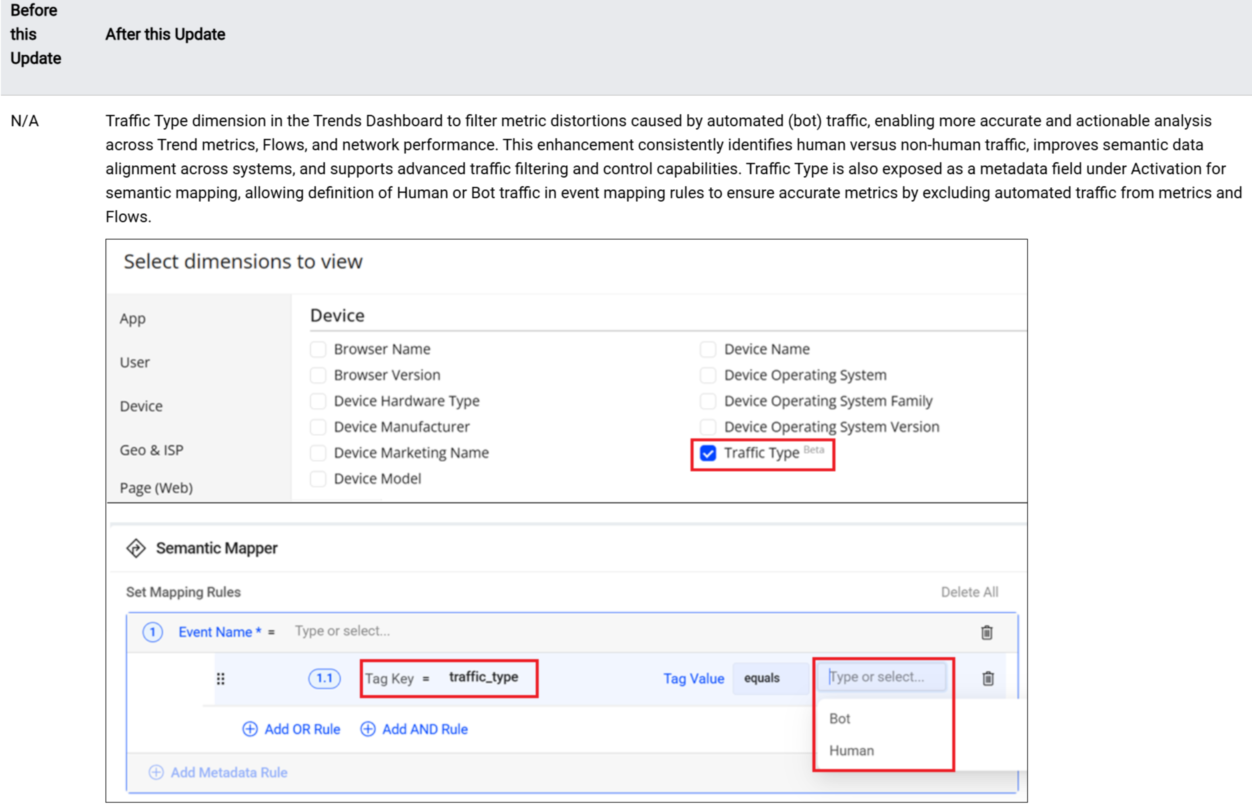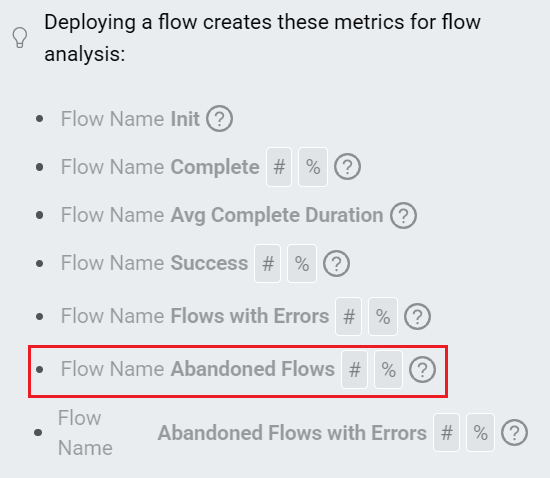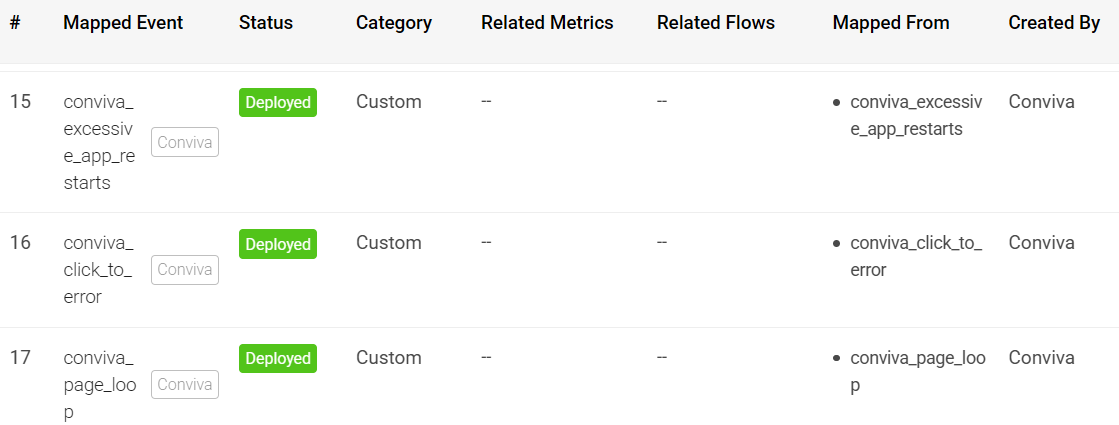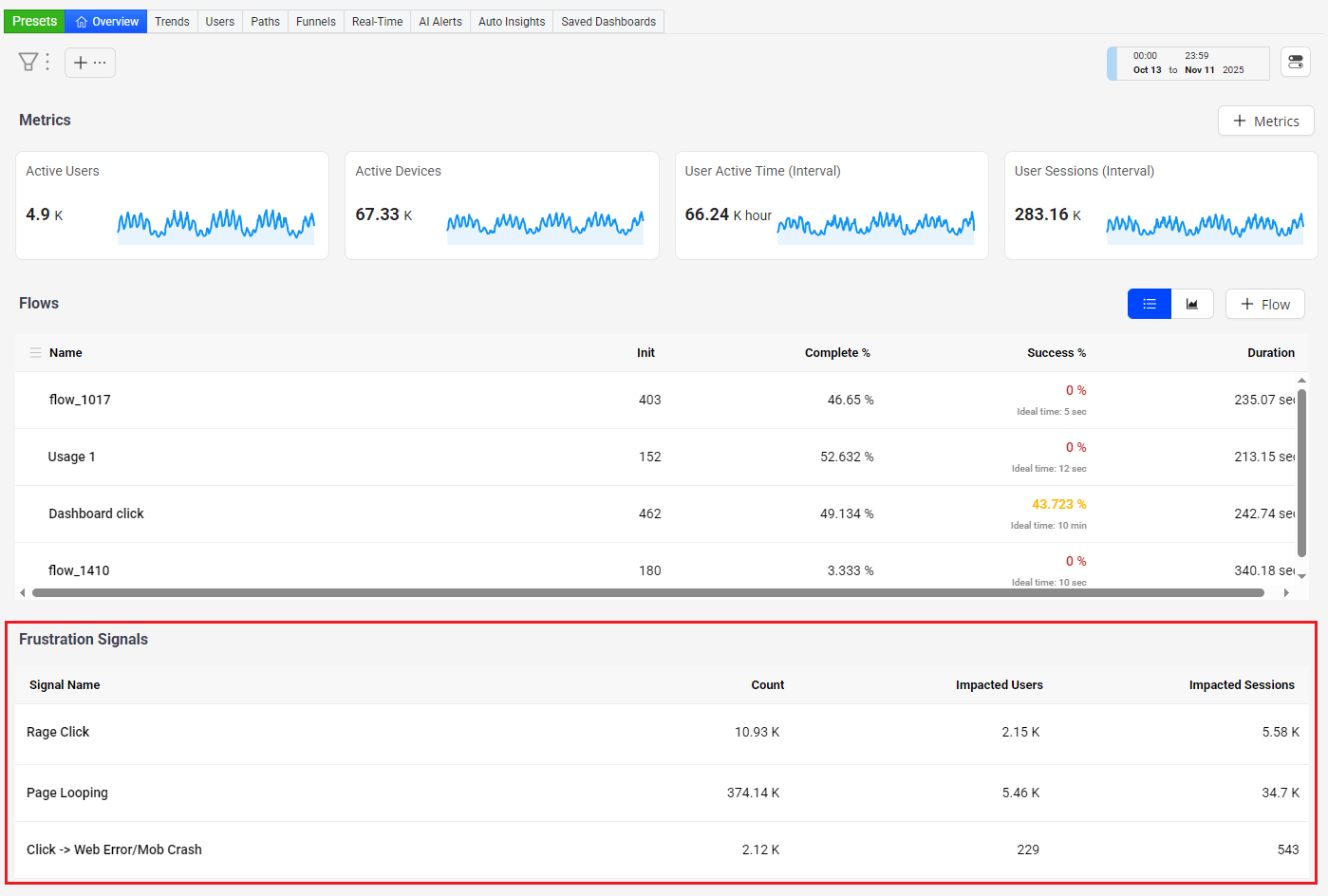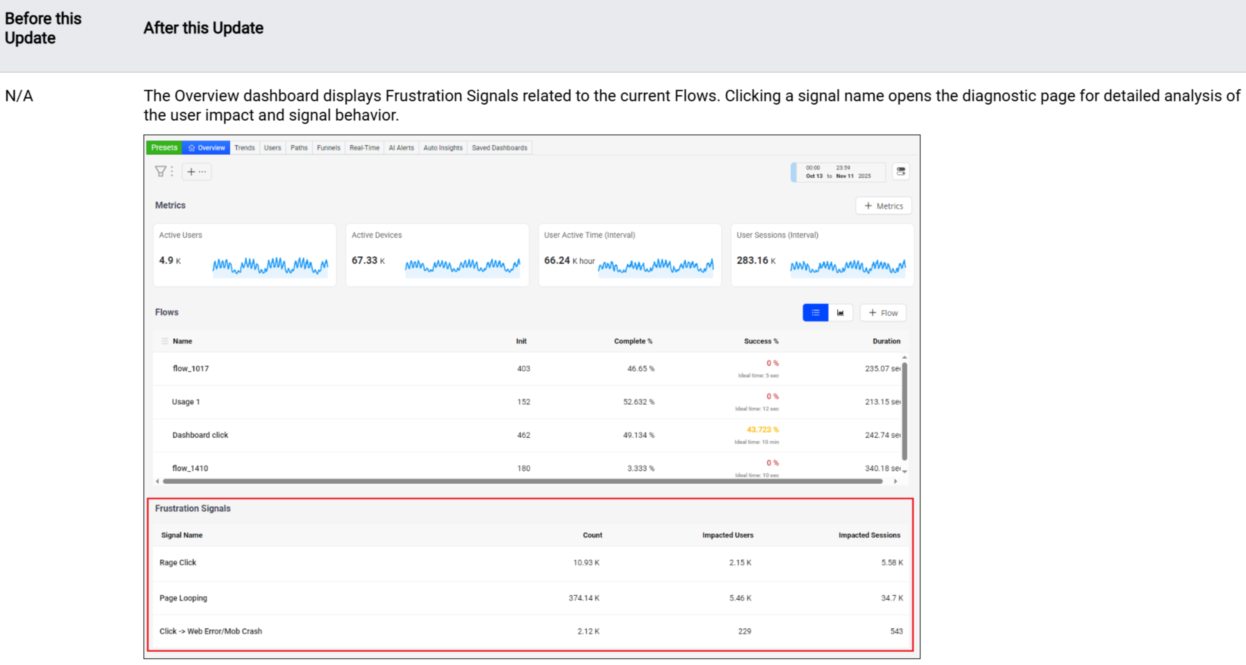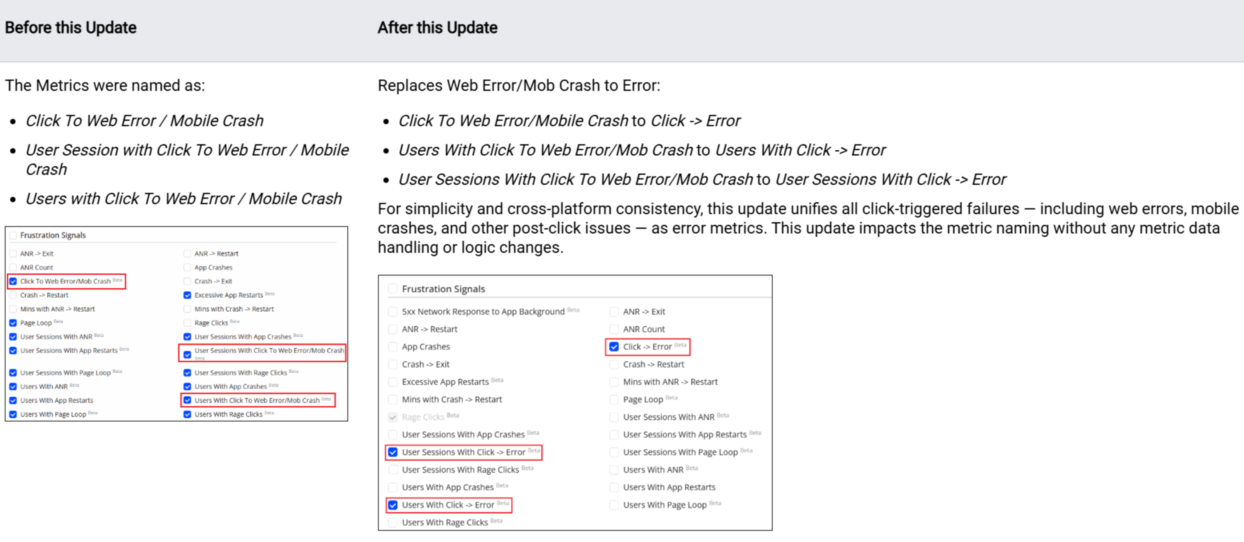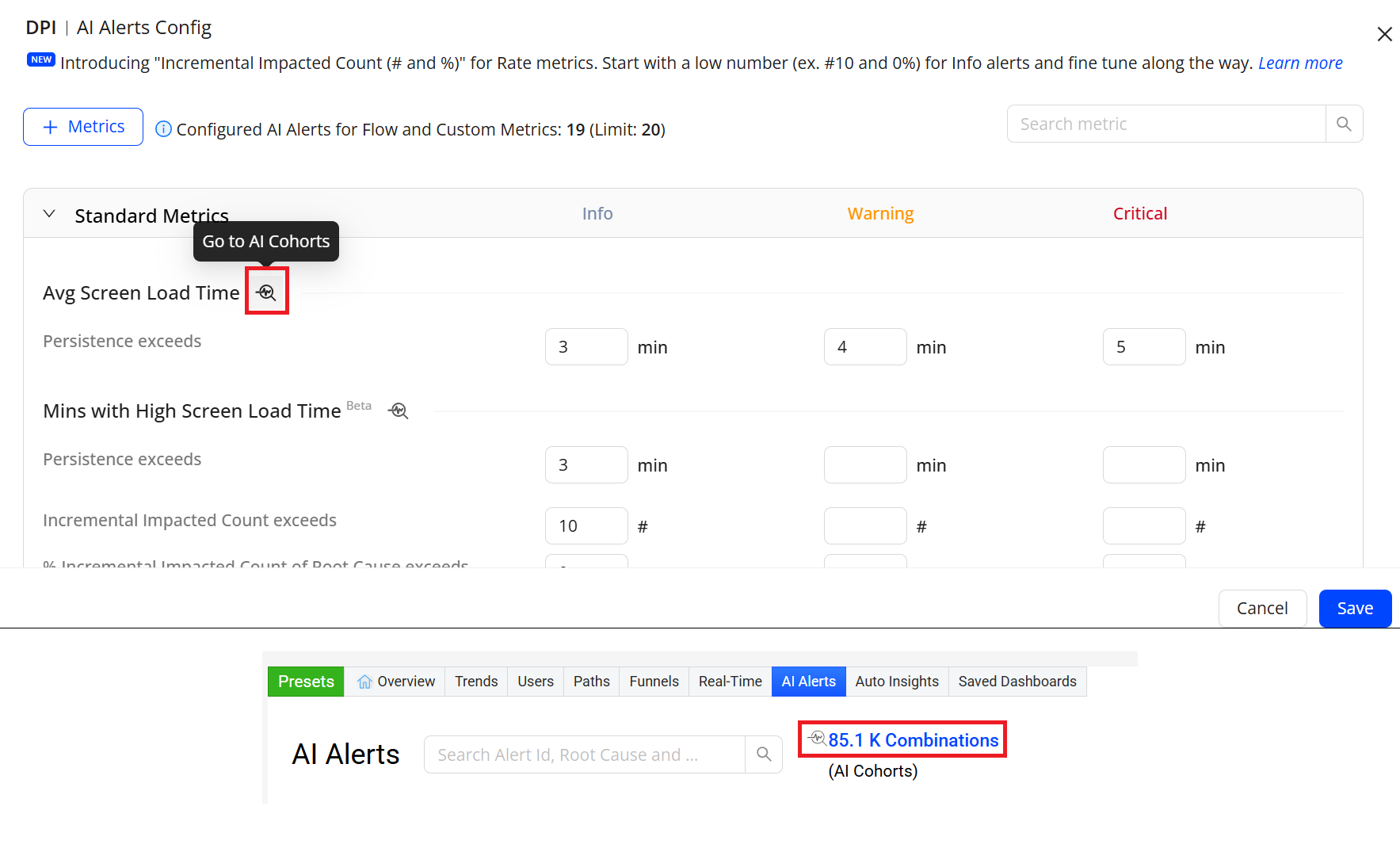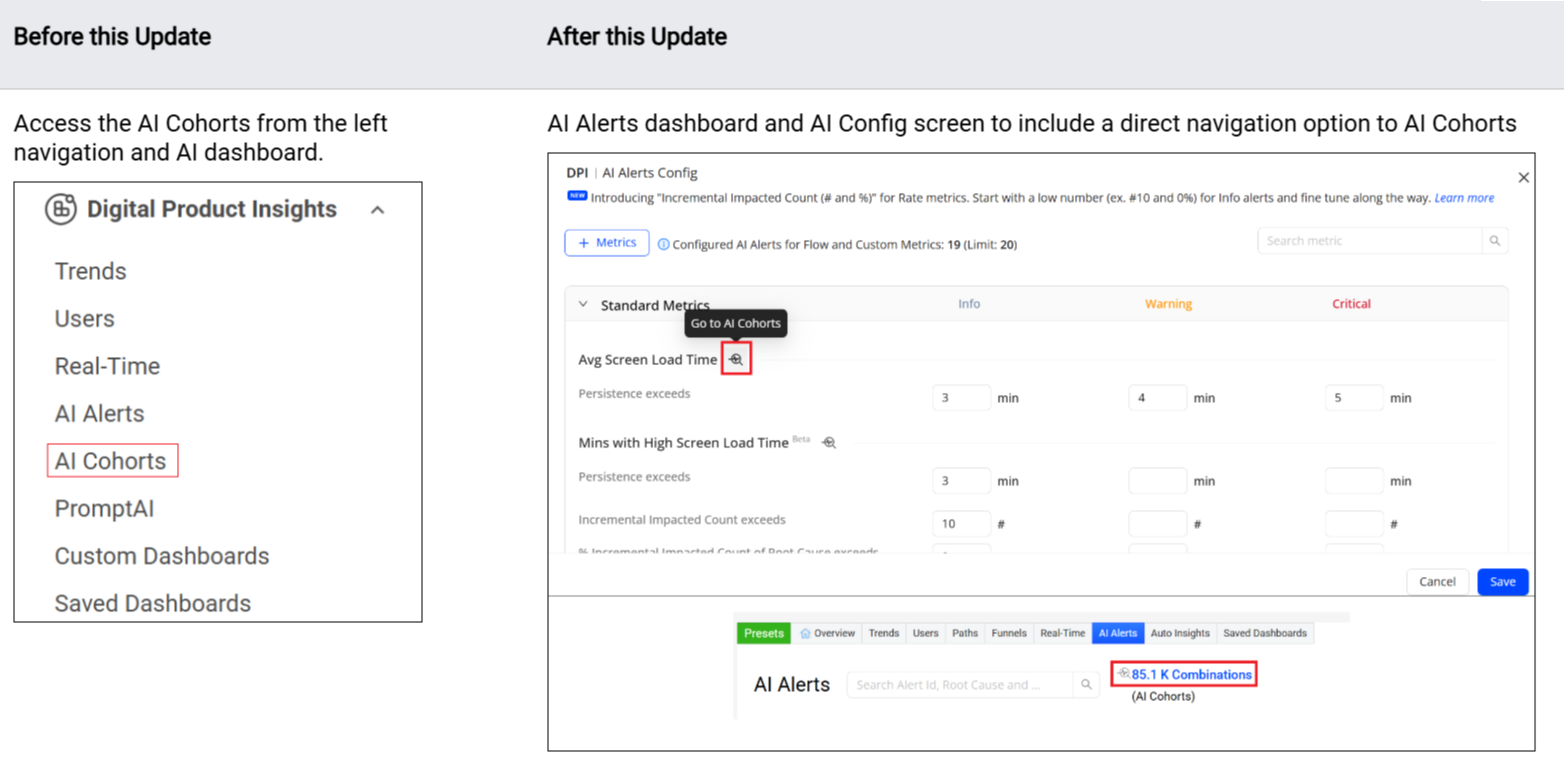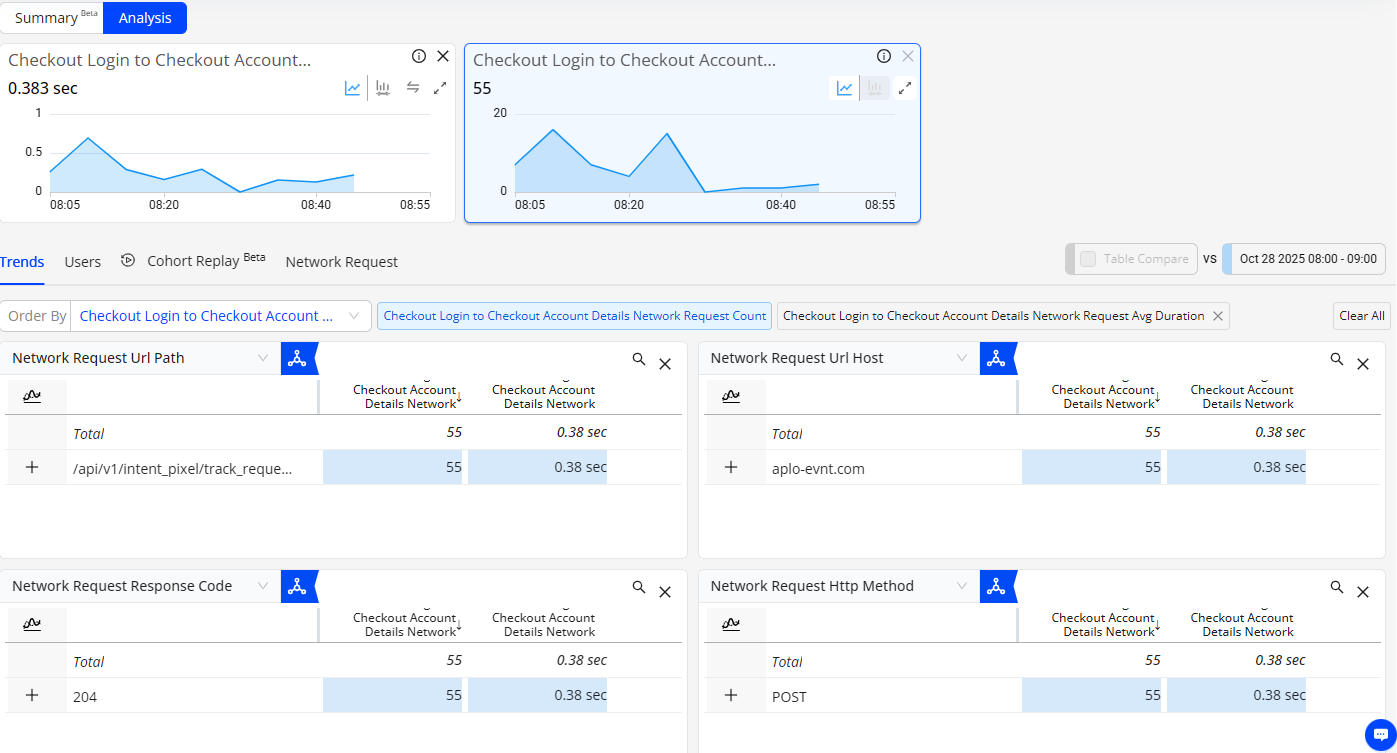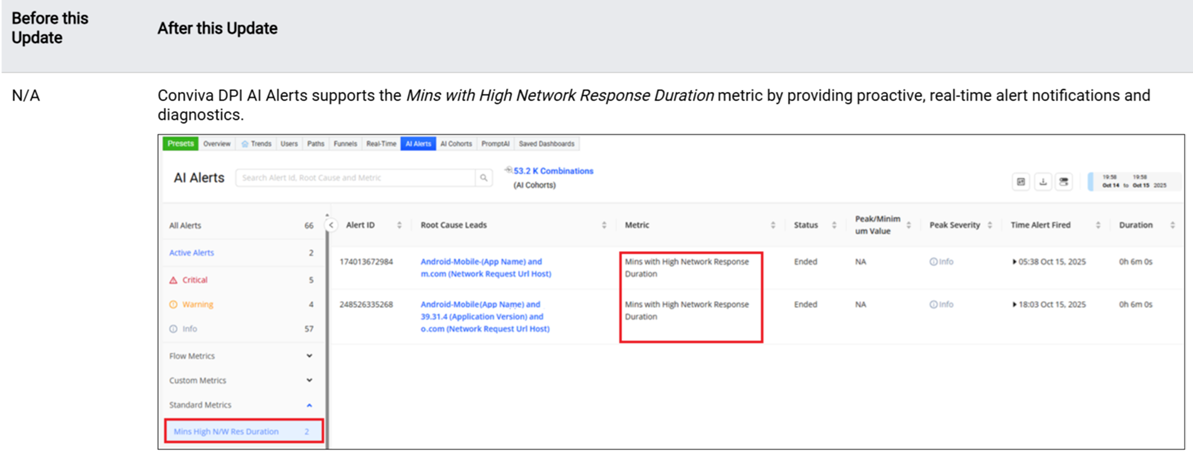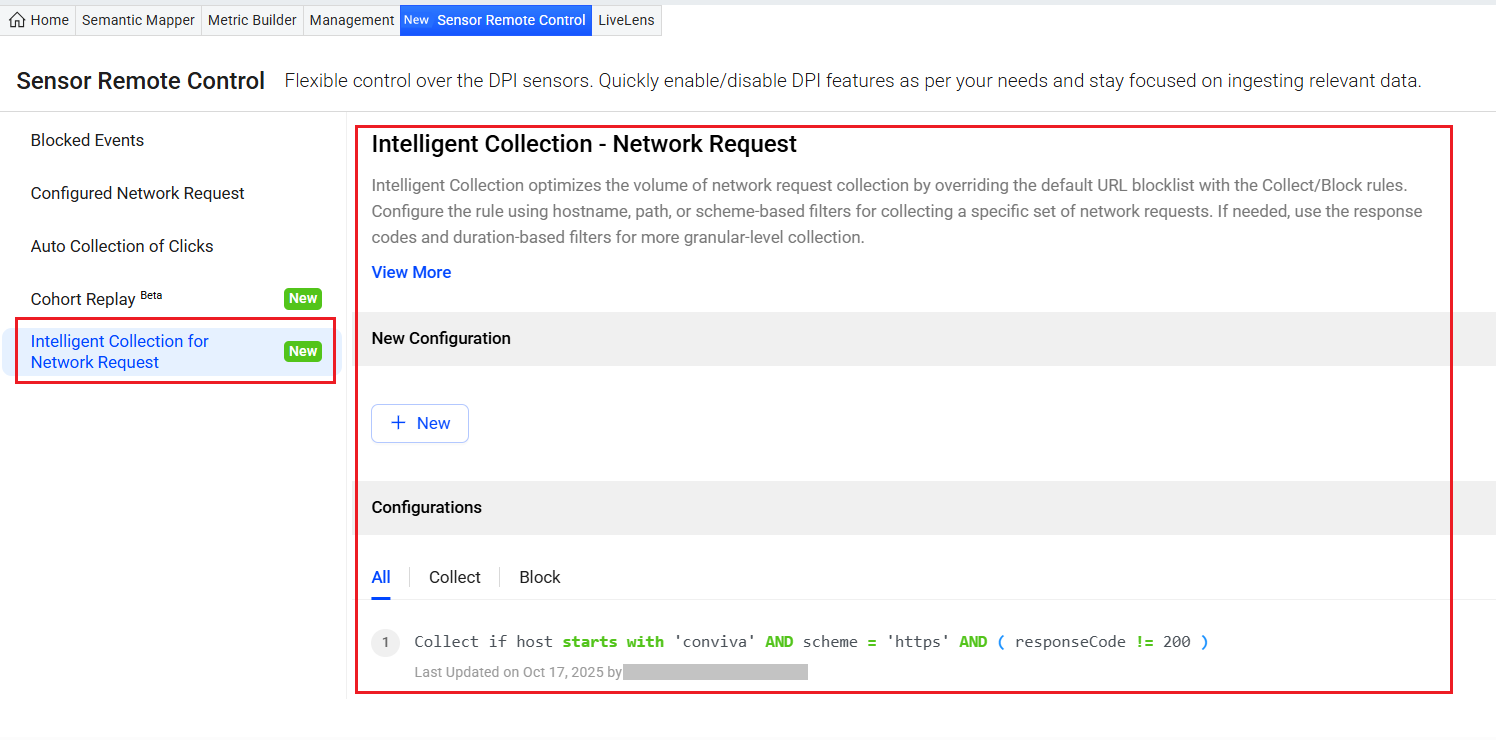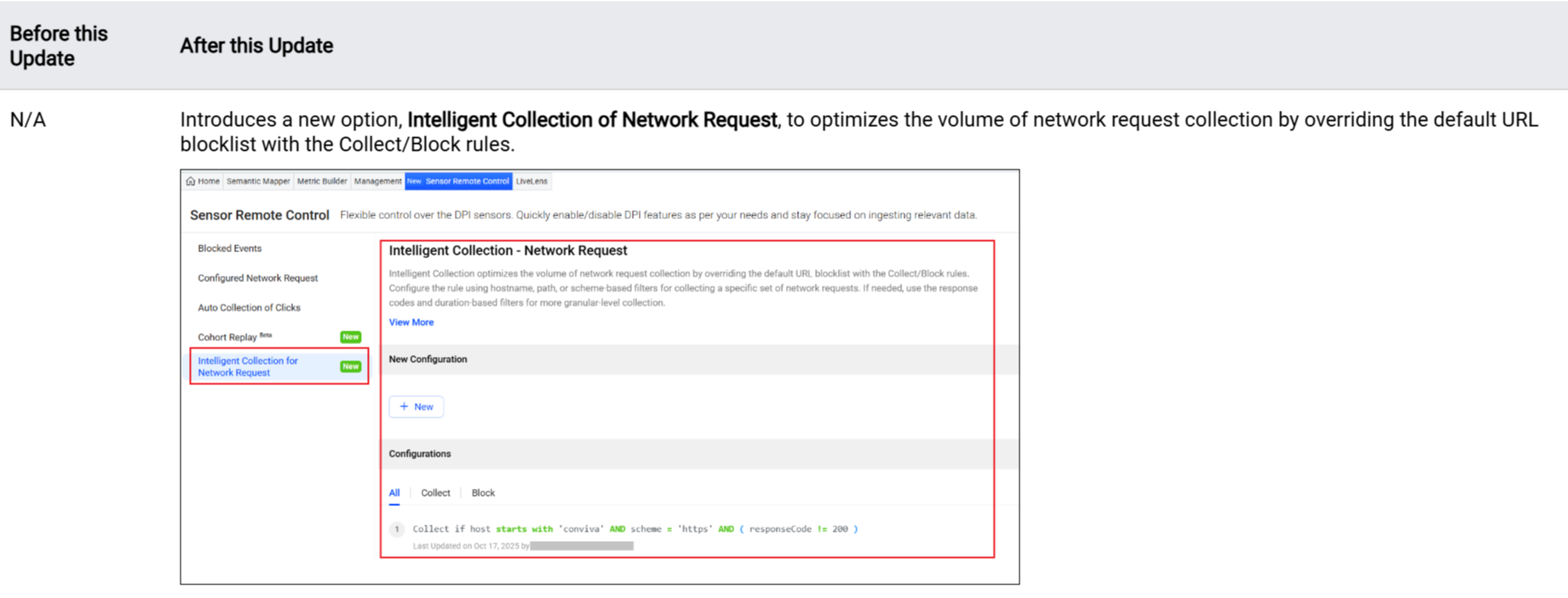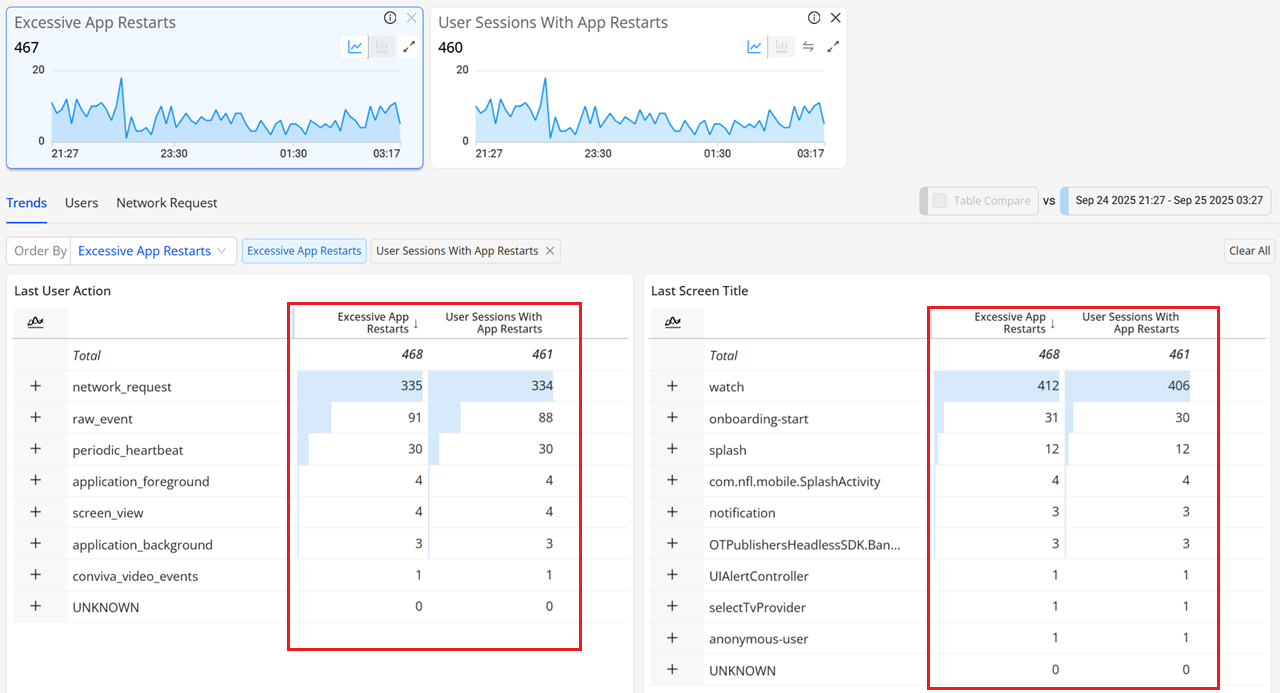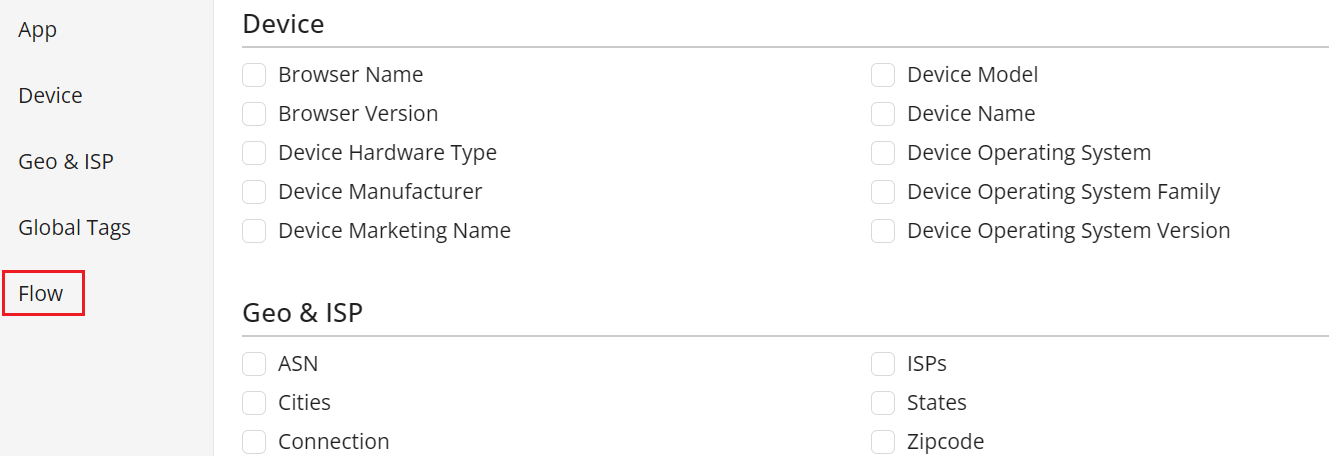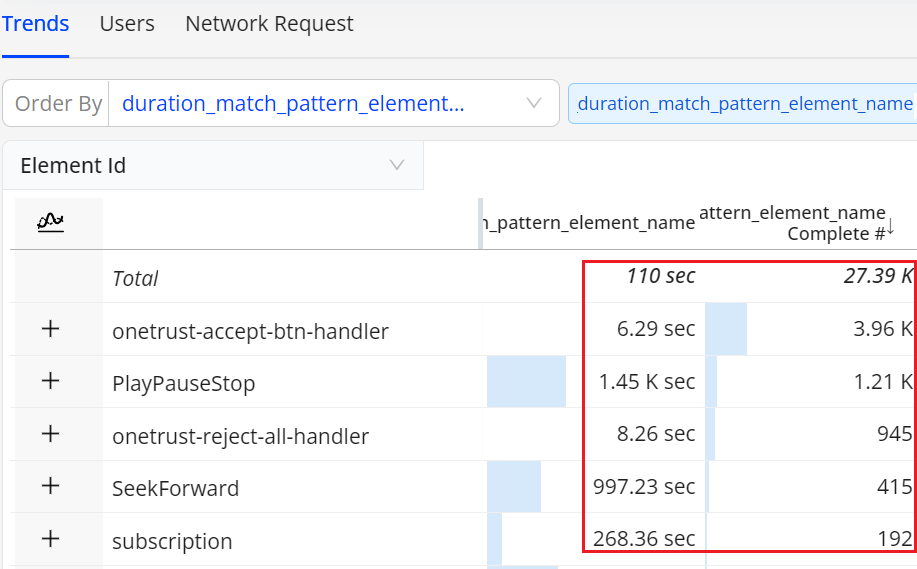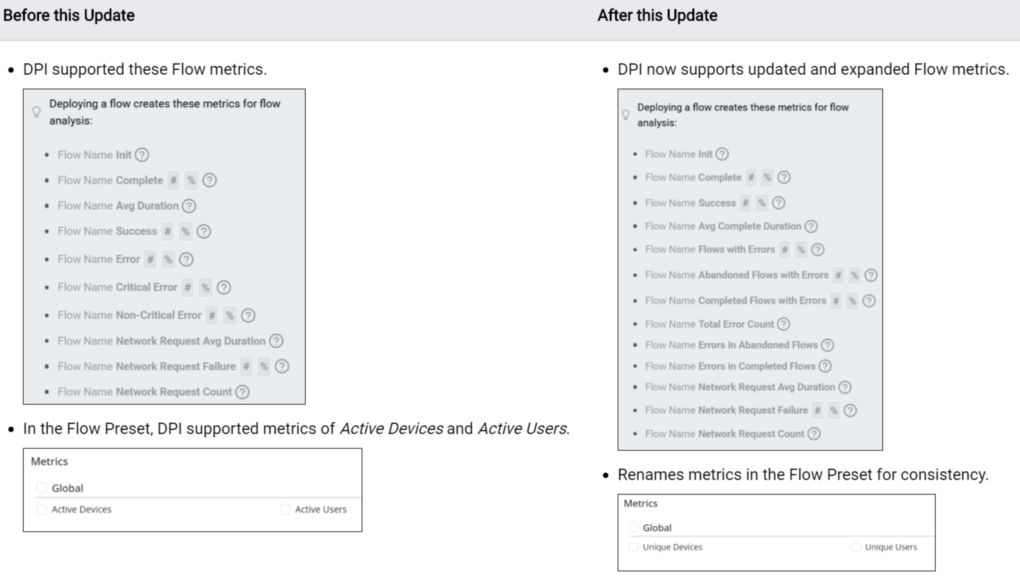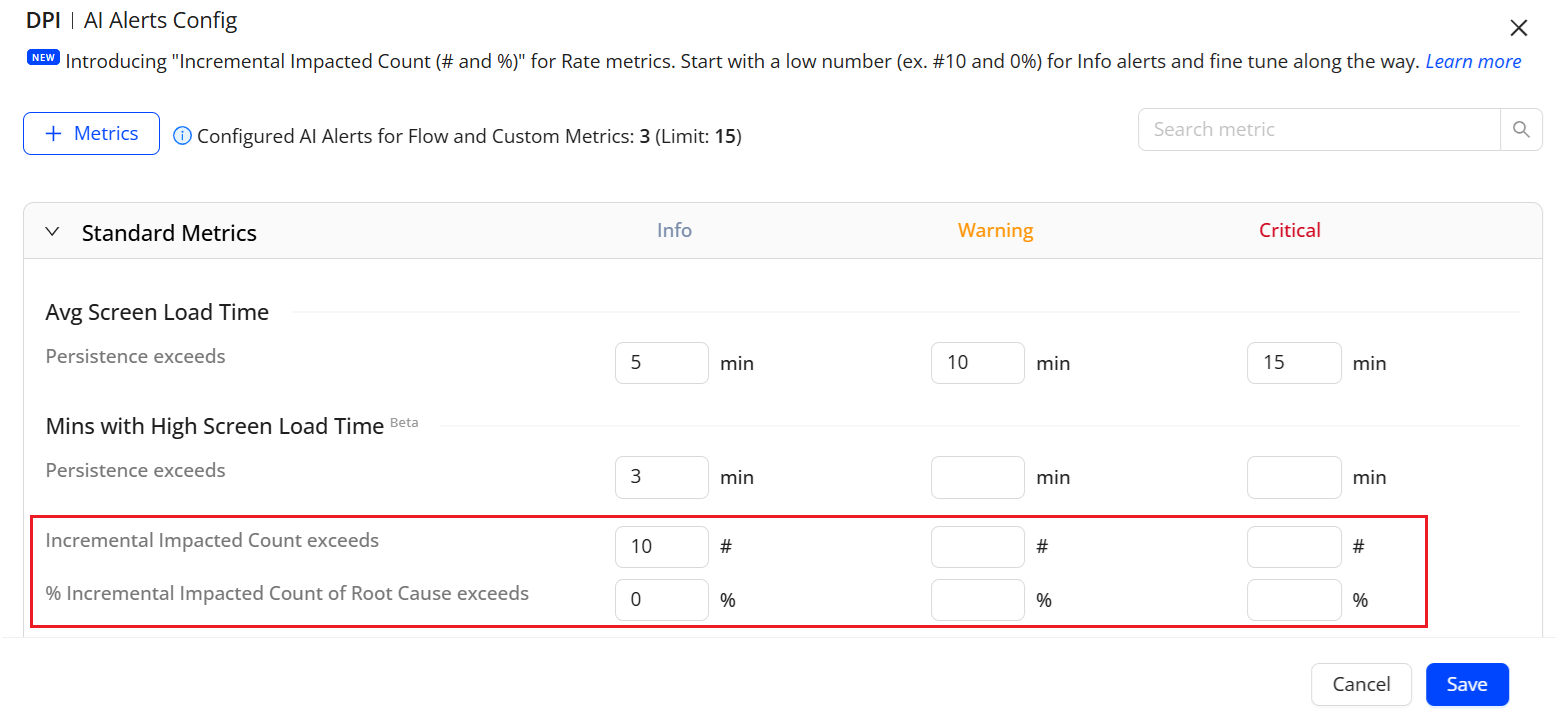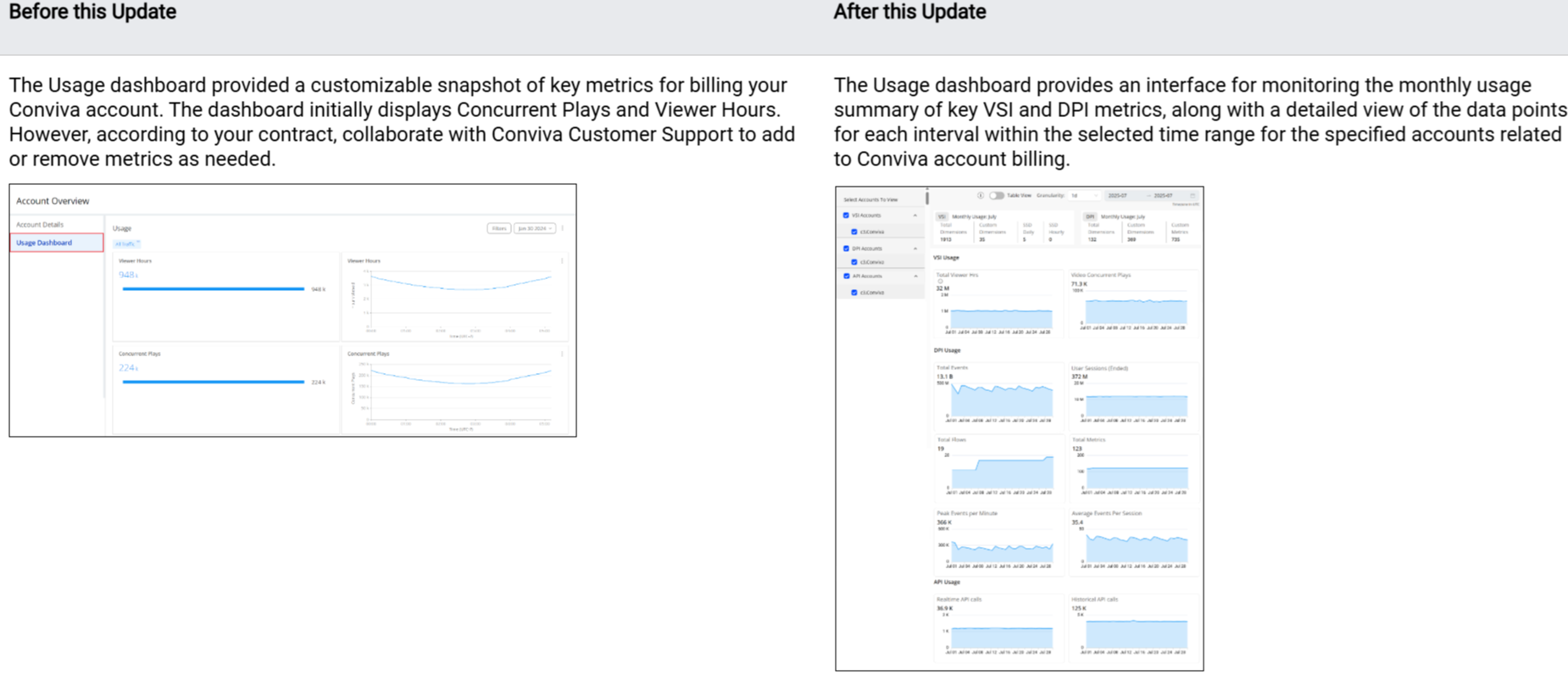Conviva DPI
 2025 Releases: Events and Metrics, Custom Dashboards, and Trends Enhancements
2025 Releases: Events and Metrics, Custom Dashboards, and Trends Enhancements
December 17, 2025
New:
Dimensions: Introduces Traffic Type as a New Dimension (Beta)
Updates:
Dimensions: Adds Traffic Type as a New Dimension (Beta)
|
|
Feature Update:
Introduces the Traffic Type dimension in the Trends Dashboard to filter metric distortions caused by automated (bot) traffic, enabling more accurate and actionable analysis across Trend metrics, Flows, and network performance. This enhancement consistently identifies human versus non-human traffic, improves semantic data alignment across systems, and supports advanced traffic filtering and control capabilities. Traffic Type is also exposed as a metadata field under Activation for semantic mapping, allowing definition of Human or Bot traffic in event mapping rules to ensure accurate metrics by excluding automated traffic from metrics and Flows.
Click to expand the image
Use Case:
Add the Traffic Type dimension to display incoming traffic as human and automated (bot) traffic. Specify the Traffic type as human to exclude bot activity from analytics and maintain accurate engagement and conversion metrics based on user experiences. Apply Traffic Type–based rules to filter, route, or control traffic based on defined criteria, such as customer identifiers or CDN partners. Validate semantic mappings to ensure consistent reporting across systems, and support performance and load testing by enabling the generation and evaluation of different traffic patterns. This task ensures accurate data analysis, effective traffic governance, and reliable system operation.
More Details: Trends.
Flow Builder: Adds an Abandoned Flows Metric
|
|
Feature Update:
Adds the Abandoned Flows metric to measure the number of Flow attempts that did not complete successfully within the user-defined Flow Duration Limit, maximum 1 hour.
This new metric enables isolation of cohorts that do not convert within the expected time, enabling deeper dimensional analysis and access to user-level details.
Click to expand the image
Use Case:
Use the Abandoned Flows and Complete Flow metrics to compare abandoned and complete Flows and identify issues that prevent Flows from meeting completion criteria, such as long network request durations or delays between user interactions and request initiation.
More Details: Flows.
Mapped Events: Adds New Out-of-Box Mapped Events
|
|
Feature Update:
Adds the pre-defined mapped events for expanded user friction analysis.
| Event Name | Supported Platform | Supported Sensor Version |
|---|---|---|
| conviva_page_loop | JS | All versions |
| conviva_click_to_error | JS, Android, iOS | JS 1.1.2 and later, Android 1.2.0 and later, iOS 1.0.2 and later |
| conviva_excessive_app_restarts | Android, iOS | Android 0.1.0 and later, iOS 0.2.0 and later |
Click to expand the image
Use Case:
Provides ready-to-use mapped events for common app behaviors, reducing setup time for analytics and monitoring friction points in user experience.
More Details: Semantic Mapper.
December 4, 2025
New:
Metrics: Adds Avg Soft Navigation Time as a new Web User Experience Metric (Beta)
Updates:
Metrics: Adds Avg Soft Navigation Time as a new Web User Experience Metric (Beta)
|
|
Feature Update:
Adds the Avg Soft Navigation Time metric to measure how users experience page rendering, based on the average time from when a page navigation is detected until the page is fully rendered and ready for user interaction. A soft navigation typically begins when a SPA changes views/routes without a full browser reload (for example, with React Router, Vue Router, or Angular Router). During this time, the app may fetch data, update components, re-render the UI, and execute JavaScript.
Click to expand the image
Use Case:
This metric helps identify when users experience slow view-to-view transitions in a Single Page Application (SPA). When a User moves from one page to another without a full page load, this metric measures the average soft navigation time, reflecting how users experience page rendering.
More Details: DPI Metrics.
Activation: Adds a Type Column to the Management Tab
|
|
Feature Update:
Adds support for displaying the Custom metric type in the Management tab of Activation. This improvement enables quick confirmation of the metric type, such as conversion, interval, and duration, for each Custom metric while viewing the other metric settings.
Click to expand the image
Use Case:
Quickly confirm a Custom metric type, such as a conversion, interval, or duration metric, to fully understand the type of metric data and deployment status.
More Details: Management.
Activation: Enables Management Data Downloads
|
|
Feature Update:
Adds support for exporting Management data in .xlsx format, enabling easier auditing of Activate changes.
Click to expand the image
Use Case:
To quickly group Custom Metrics by different usage patterns, download the data from the Management tab and sort the data in pivot tables.
More Details: Management.
Trends: Adds the Element XPath as an Event Tag
|
|
Feature Update:
Adds a new dimension, XPath, to enable more precise identification of elements related to frustration signals.
Note: XPath (XML Path Language) helps locate specific elements in an HTML structure. For example: //form[@id="login-form"]//button[text()="Submit"] — selects the Submit button nested inside a specific login form. Use XPath to target elements, such as buttons, select items from a list, or locate elements nested within components that do not have stable IDs or classes.
Click to expand the image
Use Case:
Use the Element XPath dimension to identify specific element instances based on XPath expressions for element names and attributes.
For example, on a page with multiple identical “Submit” buttons, use the Element XPath dimension to pinpoint which button is related to a crash or error based on the parent element.
More Details: Trends.
November 20, 2025
Updates:
Flow and Metric Creation: Enables Transition Event Exclusion
|
|
Feature Update:
Adds support for excluding transition events, enabling metrics and Flows based on user progression from Event A to Event C, without the occurrence of Event B. This feature enables refined insights based on more selective event progressions that eliminate unwanted transitional events.
Click to expand the image
Use Case:
Define a metric that tracks progressions from event A to event C while excluding sessions during which a transition event B occurs.
For example, measure login start to login success accurately, without considering account creation during the flow that may inflate the duration of login metrics.
More Details: Flows and Custom Metrics.
Activation: Adds Deployment Messages
|
|
Feature Update:
Adds support for displaying detailed deployment status messages when hovering over the Deploy button in Activation. This improvement enables quick verification of the latest deployment status without navigating to other tabs, enhancing deployment visibility.
Click to expand the image
Use Case:
When deploying metrics and dimensions, hover over the Deploy button to confirm the latest status, such as In Process, Failure, and Success.
More Details: Activation.
November 13, 2025
New:
-
Metrics: Adds 5xx Network Request Failure to App Background as a Frustration Metric (Beta)
-
Dimensions: Adds Designated Market Area (DMA) as a Dimension
Updates:
-
Dashboards: Adds Frustration Signals to the Overview Dashboard
-
Metric: Renames Click To Web Error/Mobile Crash Metric to Click -> Error (Beta)
Metrics: Adds 5xx Network Request Failure to App Background as a Frustration Metric (Beta)
|
|
Feature Update:
Adds the 5xx Network Request Failure to Background metric to correlate server network request issues with app state transitions to background (user inactivity). This metric counts how often a 5xx network request failure leads to the application transitioning to background within 10 seconds, highlighting server-side request-handling issues that impacted user app activity. For structured server issue analysis, DPI displays network request dimensions, such as host and path, along with the metric values.
Click to expand the image
Use Case:
With this metric time series in Trends, quickly identify when temporary web service overloads/outages due to traffic surges or service maintenance intervals cause web server 503 Network Request failures that lead to app backgrounding and user inactivity.
More Details: DPI Metrics and Introduction to Frustration Signals.
Dimensions: Adds Designated Market Area (DMA) as a Dimension
|
|
Feature Update:
Adds the Designated Market Area (DMA) dimension in Trends as part of its geographical segmentation in streaming analytics. A DMA represents a regional area in which the population receives the same (or similar) streaming content.
Click to expand the image
Use Case:
With this dimension in Trends dimension tables, quickly identify which region/district experienced increased app backgrounding (user inactivity) related to web server 503 Network Request failures.
More Details: Trends.
Flow Creation: Enables Multiple Flow Labels
|
|
Feature Update:
Enhances Flow navigation in the Overview dashboard with the display of customizable labels, improving Flow discovery and organization.
Click to expand the image
Use Case:
With Flows assigned multiple labels to indicate the targeted users by teams, Products, or use cases, (example labels: Finance, Customer Support, Operations, Login, Subscription, Onboarding),
Use the +Flow selection in the Overview dashboard to display the Flows configured your specific area of analysis. Also, in the Flow Detail page use the label selector in the top bar to easily filter and switch between Flows.
More Details: Flows.
Trends: Persists Custom Global Tag Value
|
|
Feature Update:
Custom Global Tags associated with a Flow automatically propagate the last non-null value across all the related Flow records, maintaining a consistent context throughout the Flow, even if the tag is missing in later Flow events.
Click to expand the image
Use Case:
For a Flow with UTM tags, improve UTM analysis with UTM values displayed throughout the Flow, even when the tags are present only before the start of the Flow.
More Details: Trends.
Dashboards: Adds Frustration Signals to the Overview Dashboard (Beta)
|
|
Feature Update:
Adds Frustration Signals related to the current Flows to the Overview dashboard. Clicking a signal name opens the diagnostic page for detailed analysis of the user impact and signal behavior.
Click to expand the image
Use Case:
In the Rage Click Diagnostics dashboard, slice a metric spike and use the Page URL and Element ID dimension tables to isolate the most impacted pages and elements for UI improvements.
More Details: DPI Metrics and Introduction to Frustration Signals.
Metric: Renames the Click To Web Error/Mobile Crash Metric to Click -> Error (Beta)
|
|
Feature Update:
Replaces Web Error/Mob Crash to Error:
-
Click To Web Error/Mobile Crash to Click -> Error
-
Users With Click To Web Error/Mob Crash to Users With Click -> Error
-
User Sessions With Click To Web Error/Mob Crash to User Sessions With Click -> Error
For simplicity and cross-platform consistency, this update unifies all click-triggered failures — including web errors, mobile crashes, and other post-click issues — as error metrics. This update impacts the metric naming without any metric data handling or logic changes.
Click to expand the image
Use Case:
Use the time series for Users with Click To Web Error / Mobile Crash to identify the number of Android users with a high rate of mobile app crashes and focus drill-down analysis on their sessions.
More Details: DPI Metrics and Introduction to Frustration Signals.
November 4, 2025
Updates:
Metric Creation: Enhances Ratio Metric with Fixed Number as Denominator
|
|
Feature Update:
Enhances Ratio metrics to support using a fixed number as the denominator, expanding the flexibility and applicability of Ratio metrics.
Click to expand the image
Use Case:
Use the fixed number as a Ratio metric denominator to create Ratio metrics for analyzing revenue across currencies, such as euros based on U.S. dollar data. Apply the current USD-to-EUR exchange rate as the fixed denominator to calculate the Ratio metric for common currency analysis.
More Details: Custom Metrics.
October 30, 2025
New:
Updates:
-
Trends: Enhances Flow Analysis with Network Request Dimensions
-
AI Cohorts: Removes the AI Cohort Link from the Pulse Navigation Menu
Metrics: Adds Metrics (Beta) for Excessive App Restart, Page Loop, Click → Web Error / Mobile Crash. Also, adds User Session and User Metrics for ANR, App Restart, Page Loop, Click To Web Error/Mob Crash, and Rage Clicks
|
|
Feature Update:
Frustration Signals are measurable indicators derived from user interaction data that reflect potential user dissatisfaction, confusion, or friction during a digital experience. These signals identify behavioral or technical anomalies observed in digital experiences.
Adds new Frustration metrics (Beta);
-
Excessive App Restarts measures the frequency or the number of occurrences when an application launches two or more times within a non-overlapping 60-second tumbling window. The application restarts may occur because of the app not responding, app instability, crashes, or forced closures by the user, indicating app session instability and multiple relaunches in quick succession.
-
Page Loop detects repeated page visits that likely indicate poor user experience caused by navigation issues or inconsistent state handling. This metric measures the number of 15-second intervals during which the same page URL was visited three or more times.
-
Click To Web Error / Mobile Crash captures the number and percentage of user interactions that are directly followed by a web error or mobile crash.
-
Web Error – For web users, a web error (any recorded client or server-side error event (e.g., JavaScript error)) that triggered in response to a click.
-
Mobile Crash – For mobile users, a fatal error that resulted in the immediate termination of the mobile application after a click.
-
-
Rage Clicks measures the frequency of users engaging in rapid, repetitive clicks on the same UI element, typically indicating a high level of user frustration. This metric tracks instances in which users perform three or more clicks on the same clickable UI element within a two-second time window without any meaningful interaction or response.
Enhances exisiting Frustration metrics with companion metrics for related users and user session analysis:
-
User Sessions with Page Loop measures the number of sessions that contain a page loop.
-
User Sessions With Excessive App Restarts measures the number of user sessions with Excessive App Restarts.
-
User Session with Click To Web Error / Mobile Crash measures the number of user sessions with Click → Web Error / Mobile Crash.
-
User Sessions with Rage Clicks measures the number of sessions that contain Rage Clicks.
-
Users with Page Loop measure the number of users who visited the same page URL in a web app three or more times within 15 seconds.
-
Users with Click To Web Error / Mobile Crash measure the number of users who experienced a web error or mobile crash after a click.
-
Users with Excessive App Restarts measure the number of users who experienced the app restarts (>= 2), indicating restart loops within the 60-second intervals.
-
Users with Rage Clicks measure the number of users who performed three or more clicks on the same clickable UI element within a two-second time window without any meaningful interaction or response.
Spikes and anomalies in a metric time series help quickly identify looping behavior caused by UX flaws, misconfigured redirects, or technical errors, thereby enhancing user journey efficiency and flow stability.
Click to expand the image
Use Case:
Slice a Page Loop spike in this metric time series in Trends and use the dimension tables to diagnose the issue across the related Flow dimensions for page URLs and validation errors to highlight areas for UI improvements.
Use the time series for User Sessions with Page Loop to view the number of sessions that contain page loops.
Use the time series for Users with Click To Web Error / Mobile Crash to identify the number of users who clicked the “Play” button on Android and experienced a high rate of crashes.
More Details: DPI Metrics and Introduction to Frustration Signals.
Navigation: Access AI Cohorts from AI Alerts Dashboard and AI Config
|
|
Feature Update:
Updates the AI Alerts dashboard and AI Config page to include a direct navigation option to AI Cohorts, improving usability and streamlining workflows. This enhancement allows users to seamlessly transition between related AI modules, reducing navigation time and providing a more intuitive user experience.
Click to expand the image
Use Case:
Instead of left navigation, use the option to navigate to AI Cohorts from the AI Alerts dashboard or the AI Config page for easier access.
More Details: AI Cohorts and AI Alerts.
Trends: Enhances Flow Analysis with Network Request Dimensions
|
|
Feature Update:
Automatically associates the related network request dimensions (Network Request Url Host, Network Request Http Method, Network Request Url Path, Network Request Response Code) with Flow metrics, excluding the Flow error metrics, to enhance the analysis of Flow performance.
Click to expand the image
Use Case:
Leverage the automatic association of network request dimensions with Flow metrics to drill down across the related network request dimensions and Flow metrics, and discover which request host and path impacted Flow performance.
More Details: Flows.
AI Cohorts: Enhances AI Cohorts to Customize the Knowledge Graph for Every Metric and Add Custom Dimensions.
|
|
Feature Update:
Enhances the AI Cohorts with an option to add custom dimensions and customize the Knowledge Graph for every metric. This update helps to easily configure custom dimensions as single dimensions or in groups of two or three dimensions to focus AI alerting on specific performance areas, such as an underperforming channel or CDN edge server / OS family combination.
Click to expand the image
Use Case:
Select the metric from the drop-down in this example Avg. Screen Load Time, and add the custom dimensions, along with the displayed standard dimensions, to customize the knowledge graph and focus on alerts for underperforming assets. Click the Alert to open the AI Alert dashboard, analyze the dimension data, and drill down to the anomaly.
More Details: AI Cohorts.
AI Cohorts: Removes the AI Cohort Link from the Pulse Navigation Menu
|
|
Feature Update:
AI Cohorts in the left menu is now removed. Use the option to navigate to AI Cohorts from the AI Alerts dashboard or AI Config page.
More Details: AI Cohorts and AI Alerts.
October 17, 2025
New:
-
AI Alerts: Supports AI Alerts for Mins With High Network Response Duration
-
Sensor Remote Control: New Option Intelligent Collection of Network Request
Updates:
Individual Metric Builder: Adds Support for Ratio Metrics
|
|
Feature Update:
Adds a new Ratio metric type in the Individual Metric Builder to build metrics that display the relationships or proportions using mapped event values and OOB/custom aggregation metric values, such as average order value and average session starts to checkout complete. The Ratio metric type provides an additional level of analysis in Trends, such as analyzing the rate of how many orders were made relative to how many page visits occurred. Ratio numerator and denominator values support event counts, average values, and total values from mapped events.
Click to expand the image
Use Case:
Use the Ratio metric type to analyze app performance and user activity based on customized numerator and denominator values to compute rates or averages. For example, to measure the average amount of money a customer spends, create a Revenue Per Paying User metric by selecting the related event and metric to calculate the ratio of Total Revenue to Unique Users, and then view the metric in Trends for dimensional analysis.
More Details: Custom Metrics.
AI Alerts: Supports AI Alerts for Mins With High Network Response Duration
|
|
Feature Update:
Introduces AI Alerts support for the Mins with High Network Response Duration metric. AI Alerts for this metric serve as proactive, real-time notifications of potential client, network, or server performance issues based on the configured persistence level. This notification includes alert description and related root cause details, along with alert markers in the metric time series widgets of the Trends dashboard. Click an alert to see detailed troubleshooting and optimization on the AI Alert Diagnostics page. AI Alert data can also be retrieved using the AI Alerts API and Webhooks.
Click to expand the image
Use Case:
When monitoring the Mins with High Network Response Duration metric time series in Trends, click the AI Alert marker that indicates a sudden spike in response durations beyond a configured persistence level. In the AI Alert Diagnostics page, use dimensional drill-downs to confirm the root cause and optimization steps.
More Details: AI Alerts.
Metrics: Adds Mins With xxx Network Request Response Code
|
|
Feature Update:
Introduces the Mins with xxx Network Request Response Code metrics,
-
Mins with 0 Network Response Code
-
Mins with 4xx Network Response Code
-
Mins with 5xx Network Response Code
To help analyze the different types of network request performance issues in app sessions based on the number and percentage of one-minute intervals during which the performance issues occurred. These metrics actively categorize performance issues arising from HTTP response code processing, client-side request handling, and service-side request response failures. They continuously track the frequency and impact of response codes, enabling proactive notifications and facilitating cross-dimensional drill-downs to quickly isolate and analyze network request performance issues across various dimensions.
Click to expand the image
Use Case:
Set up AI Alerts for Mins with xxx Network Response Codes to enable real-time alert messages and time series alert markers. For example, starting with a highly impacted device OS version, analyze response code impacts across network request URL hosts, paths, and endpoints to quickly focus on the most likely root cause of the persistent network request issue.
More Details: Minutes with Network Request Response Code Metrics.
Sensor Remote Control: New Option Intelligent Collection of Network Request
|
|
Feature Update:
Introduces a new option, Intelligent Collection of Network Request, to optimize the volume of network request collection by overriding the default URL blocklist with the Collect/Block rules.
Note: This feature is available only for the DPI Android 1.1.0 and above, Web (JavaScript) 1.1.1 and above, and iOS 1.0.1 and above. Conviva recommends updating the sensor to its latest version.
Click to expand the image
Use Case:
After integrating the DPI sensor with the app, use the Intelligent Collection of Network Request option under the Sensor Remote Control tab to configure the rule using hostname, path, or scheme-based filters for collecting a specific set of network requests. If needed, use the response codes and duration-based filters for more granular-level collection. This feature offers the following benefits:
-
Controlled Costs – Store and process only meaningful data, optimizing resource utilization.
-
Optimized Performance – Smaller datasets mean faster insights and lower latency.
-
Enhanced Insights – Eliminating noise helps surface key trends and anomalies.
-
System Integrity – Prevents overloading downstream systems with redundant data.
More Details: Sensor Remote Control.
Trends: Enhances Flow Analysis with Page and Screen Dimensions
|
|
Feature Update:
Adds support for associating predefined dimensions (Page Host, Page Path, Page Title, Page Referrer, Referrer Host, Screen Title, Previous Screen Title) with Flow metrics, enabling improved Flow drill-down analysis across related dimensions.
Click to expand the image
Use Case:
Use Page dimensions to highlight Flow performance across multiple pages. For example, with the Login Click to Success Flow selected in Trends, select the Page dimension and apply Flow metrics (Inits, Flows with Errors, Errors in Abandoned Flows) to the dimension table to analyze the performance of these metrics across Page dimension values.
More Details: Flows.
September 25, 2025
New:
Updates:
User Timeline: Adds Flow Timeline
|
|
Feature Update:
Adds support for Flow Timeline Index and User Timeline under the Users tab, completing the workflow of Flow analysis and enabling drill-down to sampled flow sessions where critical events are labeled in the timeline view.
Click to expand the image
Use Case:
When analyzing Abandoned Flows with Errors, identify the errors that disrupt conversion. For example, after noticing a spike in login issues, quickly identify which login errors, such as account activation issues or password expiration, are blocking logins.
More Details: Users.
Dimensions: Adds UTM Parameters in Trends
|
|
Feature Update:
Introduces the Urchin Tracking Module (UTM) parameters in Trends, enabling dimensional drill-down for tracking digital marketing performance. The UTM parameters as dimensions in Trends, enable deeper analysis of the source, medium, and context of marketing-related traffic along with DPI metrics, supporting unified data-driven decision-making.
Click to expand the image
Use Case:
Enable UTM Campaigns or IDs as a dimension in Trends to perform comparative analysis across marketing activities using DPI metrics, such as Active Users. Also, confirm app-related performance using metrics such as Mins Impacted, Avg Mins Per Page, and other engagement metrics.
More Details: Trends.
Metrics: Introduces App Restarts Metrics (Beta)
|
|
Feature Update:
Introduces the App Restarts as a Frustration metrics in Trends,
-
Excessive App Restarts : measures the number of times an application launch two or more times within a 60-seconds. The Excessive App Restarts metric highlights potential crash–restart loops caused by technical issues, poor user experience when users repeatedly relaunched the app due to failures or sluggish performance, and rare cases when device or OS-level constraints forced repeated terminations.
-
User Sessions With App Restarts : measures the number of user sessions with excessive app restarts.
By monitoring this metric, administrators can quickly identify stability and usability concerns based on the scope of impacted user session.
Click to expand the image
Use Case:
Comparing Excessive App Restarts and User Sessions with App Restarts can help quickly identify the abnormal app restarts impacting large number of users that may signal potential app crashes or a restart loop. For example, repeated spikes in Excessive App Restarts that impact large number of user sessions across a daily time series can indicate regular surges in high usage that strain system resources, such as memory, CPU, and storage, caused by memory leaks or misconfigured resource limits.Operations teams can monitor and correlate repeated-restart patterns to address stability issues before they significantly impact user experiences.
More Details: Metrics.
Trends: Enhances Dimension Support for Custom Metrics and Flows
|
|
Feature Update:
-
Combines together event-specific dimensions from the Network & Request and Errors categories into the Custom Dimension category in the Preset dashboard. This change makes it easier to select flow-related dimensions from a single category and prevents duplicate dimensions from appearing across other categories when they are tied to flow creation events.
-
Adds support for associating event-specific dimensions with custom metrics and predefined dimensions (Element Classes, Element Id, Element Name, Element Text, and Element Type) with Flow metrics, enabling drill-down analysis for both custom and Flow metrics.
Click to expand the image
Use Case:
Use event-specific dimensions to drill down into multiple metrics within the same dimension table for deeper analysis. For example, in the flow Login Click to Success, apply the Element Text dimension to compare Flow metrics such as Init, Abandoned Flows with Errors, and Errors in Abandoned Flows side by side in a single table.
More Details: Flows.
Flow Builder and Flow Preset: Updates Flow Metrics
|
|
Feature Update:
-
Renames several Flow metrics to improve clarity and enable deeper error analysis:
Previous Metric Name
New Metric Name
New Metric Name Clarifies that: Error
Flows with Errors An error occurred within the flow. Critical Error Abandoned Flows with Errors The flow failed to complete with an error. Non-Critical Error Completed Flows with Errors The flow completed with error. Avg Duration Avg Complete Duration The average duration applies to complete flows. Active Devices Unique Devices To specify the count is for unique devices. Active Users Unique Users To specify the count id for unique users. -
Adds new Flow metrics for Total Error Count, Errors in Abandoned Flows, and Errors in Completed Flows.
Click to expand the image
Use Case:
Use the new error-related Flow metrics for deeper drill-down error analysis. For example, compare Errors in Abandoned Flows with Errors in Completed Flows to identify which errors are critical and prevent flow conversion.
September 11, 2025
New:
-
Flow and Metric Creation: Adds Duration Limit Setting Option
-
DPI Dashboards: Introduces Overview Dashboard for DPI (Beta)
Updates:
Usage Dashboard: Enhances the Usage Dashboard to Monitor VSI, DPI and API Usage
Flow and Metric Creation: Adds Duration Limit Setting Option
|
|
Feature Update:
Adds support for a Flow and custom duration metric timeout setting, enabling a more focused Flow and metric analysis that excludes sessions with durations beyond the specified limit.
Click to expand the image
Use Case:
Set a flow timeout limit to align flow duration limits with specific user-journey duration limits.
For example, a 5-minute timeout limit for cart checkout Flow sessions aligns with typical checkout page timeouts and prevents outlier checkouts that last more than 5 minutes from skewing the analysis of the overall checkout Flow behaviors.
More Details: Flows and Custom Metrics.
DPI Dashboards: Introduces Overview Dashboard for DPI (Beta)
|
|
Feature Update:
Introduces the DPI Overview Dashboard with a comprehensive view of application performance and user activities in configured Flows. This dashboard enables quick identification of performance trends, user engagement levels, and potential issues in a single, consolidated interface.
Click to expand the image
Use Case:
For dips in payment checkout success, use the DPI Overview Dashboard to monitor overall Active Users and User Sessions, along with other Flow performances. A sharp drop in Checkout Success Flow at the payment step coincided with dips in other Flow performance. The AI-Alerts panel highlights multiple sessions affected by Page Load Time, causing it to time out, thus pinpointing the root cause. With this insight, the team can quickly address the anomaly, thereby reducing downtime.
More Details: Overview.
Dimensions: Introduces High Cardinality Dimensions
|
|
Feature Update:
Introduces a High Cardinality button that categorizes High Cardinality dimensions in Trends. A dimension is considered as high cardinality if more than 80% of the total dimension values are unique. Typically, High Cardinality dimensions contain millions of values where most entries are unique. Examples include Order ID, Error Code, or Search Query, with high levels of unique entries. Clicking the High Cardinality button displays the lists of up to 200 sample events from the last 24 hours. Use the Client ID or User ID links for further analysis.
Click to expand the image
Use Case:
Using the Transaction ID dimension for e-commerce platforms with high cardinality of unique Transaction IDs, the High Cardinality page displays up to 200 recent transaction IDs in a separate event table from the last 24 hours, so analysts can check issues while still relying on aggregated views (e.g., payment method, order status) for broader insights.
More Details: Trends.
AI Alerts: Introduces New Sensitivity for Rate-based Metrics
|
|
Feature Update:
Introduces new AI Alerts sensitivities for rate-based metrics and Flow success levels, based on the incremental-impacted Flows and metric-related sessions, along with the percentage deviation above the anomaly baseline.
-
Incremental Impacted Count exceeds (default set to 10)
-
% Incremental Impacted Count of the Root Cause exceeds (default set to 0%)
AI Alerts monitor the impacted counts and anomaly deviation percent settings for alert generation. For example, if the success level of the Login Success Flow drops from 98% to 95%, the anomaly baseline was 96%, and the number of Flows represented by this 1% drop is greater than or equal to the specified impacted count of 10 Flows; these conditions meet the AI alert settings (incremental impacted count exceeds 10 Flows and the anomaly baseline deviation percentage exceeds 0%).
Note: Setting higher sensitivity levels throttles the AI alert firing until a higher count and percentage are impacted. Setting extremely high settings can effectively disable AI alerting. Admins should try different sensitivity levels for different Flows and rate-based metrics to determine which levels work best for their apps.
Click to expand the image
Use Case:
Admins can set the sensitivity of rate-based metrics and Flows, such as Minutes with High Screen Load Time and Login Success flow, to determine when to receive AI Alert notifications. In this example, an alert is triggered when the impacted count goes above 10 Flows and the percentage of Flow success dips 0% or more below the Al alert anomaly baseline, notifying admins of issues impacting user logins. Clicking an AI Alert notification opens the diagnostics page with alert details and enables dimensional drill downs to analyze root causes.
More Details: AI Alert Sensitivity.
Usage Dashboard: Enhances the Usage Dashboard to Monitor VSI, DPI and API Usage
|
|
Feature Update:
The Usage Dashboard provides a centralized view of VSI and DPI consumption across all Conviva billing accounts. This dashboard enables teams to track usage at both a monthly and interval-level granularity, ensuring greater transparency and control over resource utilization.
Click to expand the image
Use Case:
Admins can review the dashboard to identify peak viewing periods and correlate them with custom-mapped engagement events. By analyzing session averages and user journey durations, the admin can point the latency issues during high-traffic intervals and can initiates targeted optimizations.
More Details: Usage Dashboard.
August 2025
For Conviva DPI 2025 June release, see DPI August 2025 Release.
July 2025
For Conviva DPI 2025 June release, see DPI July 2025 Release.
June 2025
For Conviva DPI 2025 June release, see DPI June 2025 Release.
May 2025
For Conviva DPI 2025 May release, see ECO May 2025 Release.
April 2025
For Conviva ECO 2025 April release, see ECO April 2025 Release.
March 2025
For Conviva ECO 2025 March release, see ECO Mar 2025 Release.
Feb 2025
For Conviva ECO 2025 Feb release, see ECO Feb 2025 Release.
Jan 2025
For Conviva ECO 2025 Jan release, see ECO Jan 2025 Release.
2024 Releases
For Conviva ECO 2024 releases, see ECO 2024 Releases.
2023 Releases
For Conviva ECO 2023 releases, see ECO 2023 Releases.

